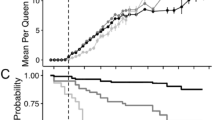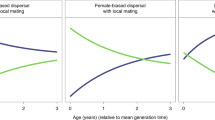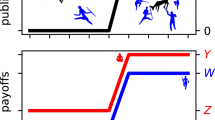Abstract
Altruism between close relatives can be easily explained. However, paradoxes arise when organisms divert altruism towards more distantly related recipients. In some social insects, workers drift extensively between colonies and help raise less related foreign brood, seemingly reducing inclusive fitness. Since being highlighted by W. D. Hamilton, three hypotheses (bet hedging, indirect reciprocity and diminishing returns to cooperation) have been proposed for this surprising behaviour. Here, using inclusive fitness theory, we show that bet hedging and indirect reciprocity could only drive cooperative drifting under improbable conditions. However, diminishing returns to cooperation create a simple context in which sharing workers is adaptive. Using a longitudinal dataset comprising over a quarter of a million nest cell observations, we quantify cooperative payoffs in the Neotropical wasp Polistes canadensis, for which drifting occurs at high levels. As the worker-to-brood ratio rises in a worker’s home colony, the predicted marginal benefit of a worker for expected colony productivity diminishes. Helping related colonies can allow effort to be focused on related brood that are more in need of care. Finally, we use simulations to show that cooperative drifting evolves under diminishing returns when dispersal is local, allowing altruists to focus their efforts on related recipients. Our results indicate the power of nonlinear fitness effects to shape social organization, and suggest that models of eusocial evolution should be extended to include neglected social interactions within colony networks.
This is a preview of subscription content, access via your institution
Access options
Access Nature and 54 other Nature Portfolio journals
Get Nature+, our best-value online-access subscription
$29.99 / 30 days
cancel any time
Subscribe to this journal
Receive 12 digital issues and online access to articles
$119.00 per year
only $9.92 per issue
Buy this article
- Purchase on Springer Link
- Instant access to full article PDF
Prices may be subject to local taxes which are calculated during checkout




Similar content being viewed by others
Data availability
The transitions data for P. canadensis are available in the Supplementary Information.
Code availability
The statistical code and individual-based simulation code are available in the Supplementary Information.
References
Gardner, A., West, S. A. & Wild, G. The genetical theory of kin selection. J. Evol. Biol. 24, 1020–1043 (2011).
Gardner, A. The purpose of adaptation. Interface Focus 7, 20170005 (2017).
Grafen, A. Optimization of inclusive fitness. J. Theor. Biol. 238, 541–563 (2006).
Bourke, A. F. G. The validity and value of inclusive fitness theory. Proc. R. Soc. B Biol. Sci. 278, 3313–3320 (2011).
Nonacs, P. Go high or go low? Adaptive evolution of high and low relatedness societies in social Hymenoptera. Front. Ecol. Evol. 5, 87 (2017).
Helanterä, H., Strassmann, J. E., Carrillo, J. & Queller, D. C. Unicolonial ants: where do they come from, what are they and where are they going? Trends Ecol. Evol. 24, 341–349 (2009).
Hamilton, W. D. The genetical evolution of social behaviour. II. J. Theor. Biol. 7, 17–52 (1964).
Queller, D. C. & Strassmann, J. E. The many selves of social insects. Science 296, 311–313 (2002).
Tsuchida, K. & Itô, Y. Internidal drifting and dominance behaviour in Polistes jadwigae Dalla Torre workers (Hymenoptera: Vespidae). J. Ethol. 5, 83–85 (1987).
Page, R., Post, D. & Metcalf, R. Satellite nests, early males, and plasticity of reproductive behavior in a paper wasp. Am. Nat. 134, 731–748 (1989).
Pickering, J. Sex Ratio, Social Behaviour, and Ecology in Polistes (Hymenoptera, Vespidae), Pachysomoides (Hymenoptera, Ichneumonidae) and Plasmodium (Protozoa, Haemosporida). PhD Thesis, Harvard Univ. (1980).
Sumner, S., Lucas, E., Barker, J. & Isaac, N. Radio-tagging technology reveals extreme nest-drifting behavior in a eusocial insect. Curr. Biol. 17, 140–145 (2007).
Grinsted, L. & Field, J. Market forces influence helping behaviour in cooperatively breeding paper wasps. Nat. Commun. 8, 13750 (2017).
Beekman, M. & Oldroyd, B. P. When workers disunite: intraspecific parasitism by eusocial bees. Annu. Rev. Entomol. 53, 19–37 (2008).
Gadagkar, R. Origin and evolution of eusociality: a perspective from studying primitively eusocial wasps. J. Genet. 69, 113–125 (1990).
Nonacs, P. & Kapheim, K. M. Social heterosis and the maintenance of genetic diversity. J. Evol. Biol. 20, 2253–2265 (2007).
Weigel, R. M. The distribution of altruism among kin: a mathematical model. Am. Nat. 118, 191–201 (1981).
Grinsted, L. & Field, J. Predictors of nest growth: diminishing returns for subordinates in the paper wasp Polistes dominula. Behav. Ecol. Sociobiol. 72, 88 (2018).
Michener, C. Reproductive efficiency in relation to colony size in hymenopterous societies. Insectes Soc. 11, 317–341 (1964).
Bulmer, M. G. Risk avoidance and nesting strategies. J. Theor. Biol. 106, 529–535 (1984).
Hopper, K., Rosenheim, J., Prout, T. & Oppenheim, S.Within-generation bet hedging: a seductive explanation? Oikos 101, 219–222 (2003).
Davies, N. G., Ross, L. & Gardner, A. The ecology of sex explains patterns of helping in arthropod societies. Ecol. Lett. 19, 862–872 (2016).
Sumner, S., Kelstrup, H. & Fanelli, D. Reproductive constraints, direct fitness and indirect fitness benefits explain helping behaviour in the primitively eusocial wasp, Polistes canadensis. Proc. R. Soc. B Biol. Sci. 277, 1721–1728 (2010).
Ferreira, P. G. et al. Transcriptome analyses of primitively eusocial wasps reveal novel insights into the evolution of sociality and the origin of alternative phenotypes. Genome Biol. 14, R20 (2013).
Southon, R. J. et al. High indirect fitness benefits for helpers across the nesting cycle in the tropical paper wasp Polistes canadensis. Mol. Ecol. 28, 3271–3284 (2019).
Wenzel, J. W. & Pickering, J. Cooperative foraging, productivity, and the central limit theorem. Proc. Natl Acad. Sci. USA 88, 36–38 (1991).
Lengronne, T. et al. Little effect of seasonal constraints on population genetic structure in eusocial paper wasps. Ecol. Evol. 2, 2610–2619 (2012).
Davies, N. G. & Gardner, A. Monogamy promotes altruistic sterility in insect societies. R. Soc. Open Sci. 5, 172190 (2018).
Schulman, S. R. & Rubenstein, D. I. Kinship, need, and the distribution of altruism. Am. Nat. 121, 776–788 (1983).
Kramer, B. H., Scharf, I. & Foitzik, S. The role of per-capita productivity in the evolution of small colony sizes in ants. Behav. Ecol. Sociobiol. 68, 41–53 (2014).
Tindo, M., Kenne, M. & Dejean, A. Advantages of multiple foundress colonies in Belonogaster juncea juncea L.: greater survival and increased productivity. Ecol. Entomol. 33, 293–297 (2008).
Naug, D. & Wenzel, J. Constraints on foraging success due to resource ecology limit colony productivity in social insects. Behav. Ecol. Sociobiol. 60, 62–68 (2006).
Clouse, R. Some effects of group size on the output of beginning nests of Mischocyttarus mexicanus (Hymenoptera: Vespidae). Florida Entomol. 84, 418–425 (2001).
Smith, A. R., Wcislo, W. T. & O’Donnel, S.Survival and productivity benefits to social nesting in the sweat bee Megalopta genalis (Hymenoptera: Halictidae). Behav. Ecol. Sociobiol. 61, 1111–1120 (2007).
Bouwma, A. M., Nordheim, E. V. & Jeanne, R. L. Per-capita productivity in a social wasp: no evidence for a negative effect of colony size. Insectes Soc. 53, 412–419 (2006).
Shreeves, G. & Field, J. Group size and direct fitness in social queues. Am. Nat. 159, 81–95 (2002).
Parsons, P. J., Grinsted, L. & Field, J. Partner choice correlates with fine scale kin structuring in the paper wasp Polistes dominula. PLoS ONE 14, e0221701 (2019).
Helanterä, H. Supercolonies of ants. In Encyclopedia of Social Insects (ed. Starr, C. K.) (Springer, 2020); https://doi.org/10.1007/978-3-319-90306-4_121-1
Holzer, B., Keller, L. & Chapuisat, M. Genetic clusters and sex-biased gene flow in a unicolonial Formica ant. BMC Evol. Biol. 9, 69 (2009).
Boomsma, J. J., Huszár, D. B. & Pedersen, J. S. The evolution of multiqueen breeding in eusocial lineages with permanent physically differentiated castes. Anim. Behav. 92, 241–252 (2014).
Keller, L. Social life: the paradox of multiple-queen colonies. Trends Ecol. Evol. 10, 355–360 (1995).
Mora-Kepfer, F. Context-dependent acceptance of non-nestmates in a primitively eusocial insect. Behav. Ecol. Sociobiol. 68, 363–371 (2013).
Couvillon, M. J. et al. En garde: rapid shifts in honeybee, Apis mellifera, guarding behaviour are triggered by onslaught of conspecific intruders. Anim. Behav. 76, 1653–1658 (2008).
McNamara, J. Optimal patch use in a stochastic environment. Theor. Popul. Biol. 21, 269–288 (1982).
Foster, K. R. Diminishing returns in social evolution: the not-so-tragic commons. J. Evol. Biol. 17, 1058–1072 (2004).
Sibly, R. M. & Curnow, R. N. Selfishness and altruism can coexist when help is subject to diminishing returns. Heredity 107, 167–173 (2011).
Cant, M. A. A tale of two theories: parent–offspring conflict and reproductive skew. Anim. Behav. 71, 255–263 (2006).
Dugatkin, L. A. The Altruism Equation: Seven Scientists Search for the Origins of Goodness (Princeton Univ. Press, 2006).
Altmann, S. Altruistic behaviour: the fallacy of kin deployment. Anim. Behav. 27, 958–962 (1979).
Dawkins, R. Twelve misunderstandings of kin selection. Z. Tierpsychol. 51, 184–200 (1979).
Rice, S. H. The Expected Value of the Ratio of Correlated Random Variables (Texas Tech Univ., 2015); https://go.nature.com/361lo0B
Zivot, E. Introduction to Computational Finance and Financial Econometrics with R (2016); https://go.nature.com/2Kz6IhL
Shpak, M. Evolution of variance in offspring number: the effects of population size and migration. Theory Biosci. 124, 65–85 (2005).
Starrfelt, J. & Kokko, H. Bet-hedging—a triple trade-off between means, variances and correlations. Biol. Rev. 87, 742–755 (2012).
Taylor, P. & Frank, S. How to make a kin selection model. J. Theor. Biol. 180, 27–37 (1996).
Rice, S. H. A stochastic version of the Price equation reveals the interplay of deterministic and stochastic processes in evolution. BMC Evol. Biol. 8, 262 (2008).
Kemeny, J. G. & Snell, J. Finite Markov Chains (Springer, 1983).
Plummer, M. rjags: Bayesian graphical models using MCMC. Version 4-9 (2019); http://mcmc-jags.sourceforge.net
Bell, A., Fairbrother, M. & Jones, K. Fixed and random effects models: making an informed choice. Qual. Quant. 53, 1051–1074 (2019).
Mundlak, Y. On the pooling of time series and cross section data. Econometrica 46, 69–85 (1978).
Hooten, M. B. & Hobbs, N. T. A guide to Bayesian model selection for ecologists. Ecol. Monogr. 85, 3–28 (2015).
Ntzoufras, I. Gibbs variable selection using BUGS. J. Stat. Softw. 7, 1–19 (2002).
Dias, S., Sutton, A. J., Ades, A. E. & Welton, N. J. Evidence synthesis for decision making 2: a generalized linear modeling framework for pairwise and network meta-analysis of randomized controlled trials. Med. Decis. Mak. 33, 607–617 (2013).
Grinstead, C. M. & Snell, J. L. Introduction to Probability 2nd edn (American Mathematical Society, 2000).
Acknowledgements
P.K. was funded by a Smithsonian Tropical Research Institute (STRI) Short-Term Fellowship (hosted by W. Wcislo), the National Geographic Society (GEF-NE 145-15) and a European Research Council Grant to A.N.R. (award number 682253). S.S. was funded by the Natural Environmental Research Council (NE/M012913/2). A.D.H. was funded by the Natural Environment Research Council (NE/L011921/1). A.N.R. was funded by a European Research Council Consolidator Grant (award number 682253). Simulations were run on the University of Bristol’s high-performance computing facility, BlueCrystal. B. Wharam and A. C. Chadwick assisted with data entry. We are very grateful for the support of the Panamanian authorities for this project; data were collected in accordance with Panamanian law under a Ministerio del Ambiente research permit (SE/A-46-16) and Ministerio de Economía y Finanzas authorization for field site access (024-2016). We thank the generous support of STRI at Galeta Field Station.
Author information
Authors and Affiliations
Contributions
P.K., S.S. and A.N.R. planned the field data collection. P.K. and P.B. collected the field data. P.K. and A.D.H. conducted the modelling. P.K., N.J.W. and A.N.R. conducted the statistical analysis. P.K., S.S. and A.N.R. interpreted the results. P.K. drafted the manuscript and all authors contributed to its development.
Corresponding author
Ethics declarations
Competing interests
The authors declare no competing interests.
Additional information
Peer review information Nature Ecology & Evolution thanks Michael Cant, Petri Rautiala and Christina Riehl for their contribution to the peer review of this work. Peer reviewer reports are available.
Publisher’s note Springer Nature remains neutral with regard to jurisdictional claims in published maps and institutional affiliations.
Extended data
Extended Data Fig. 1 Diminishing returns can allow the invasion of cooperative drifting.
a, The parameter T captures the level of diminishing returns in the model. b, Candidate equilibrium levels of drifting predicted by Eq. 3 of the main text, for illustrative values: d=0.5, x=0.75, ϕ=1, z=0.25.
Extended Data Fig. 2 Candidate equilibrium drifting levels from a colony with ϕ1=1.
We assume a monomorphic sex ratio \(\bar z\) and level of female helping \(\bar x\) common to all colonies. Diminishing returns become more likely drivers of cooperative drifting as the level of helping rises (top left corner). \(\bar m = 1\), ϕ1=1, d♀=d♂=0.5.
Extended Data Fig. 3 Repeat observations (n = 257,867) were made of all brood cells on 91 post-emergence colonies over a 56-day period, recording eight developmental states, empty cells, and death due to parasitism (sarcophagid flies and ichneumonid wasps).
Brood pass through a clear developmental sequence of changing size, colour, and mouthpart complexity, which allows categorisation of larvae into stereotyped morphological categories on their transition from egg to pupa. Image adapted with permission from J. Pickering (http://go.nature.com/2Lq1QLY).
Extended Data Fig. 4 Main effects on the probability of transitions in the Markov model of wasp development.
Transitions corresponding to steps through the Markov model states (represented in Fig. 2b of the main text) are shown along the horizontal axis. For instance, the first transition on the left is 1→3, and the effect is negative (below the dashed line): accordingly, the model fits a negative association (at a between-colony level) between nest emptiness (‘nest state effect’) and the probability that an individual egg (state 1) transitions to larval state 3 in a 5-day interval. Only main effects whose 95% credible intervals do not overlap zero are shown. In the main text, we focus on whether increased worker number and/or worker-to-brood ratio is associated with higher productivity. When considering between-colony variation (‘between-colony worker number effect’ in the figure), worker number increases brood development pace and reduces brood death. Higher worker-to-brood ratios (‘between-colony worker-to-brood ratio effect’ in the figure) increase brood developmental pace.
Extended Data Fig. 5 Posterior mean of the total residual deviance.
Deviance explained is the posterior mean of the total residual deviance of the fitted model as a percentage of the null posterior mean residual deviance (for an intercepts-only model). There are seven models, corresponding to the seven starting states.
Extended Data Fig. 6 Residual deviance against worker number.
Residual deviance contributions by each 5-day colony-observation, plotted against the predictor ‘worker number’ (xworkers).
Extended Data Fig. 7 Residual deviance against worker-to-brood ratio.
Residual deviance contributions by each 5-day colony-observation, plotted against the predictor ‘worker-to-brood ratio’ (xratio).
Extended Data Fig. 8 Residual deviance against brood number.
Residual deviance contributions by each 5-day colony-observation, plotted against the predictor ‘brood number’ (xbrood).
Extended Data Fig. 9 Proportion of cells that are empty.
Predictions for between-colony effects plotted in Fig. 3 in the main text take the mean proportion emptiness across colony-observations (dashed red line).
Supplementary information
Supplementary Information
Notation, supplementary information for the Taylor–Frank model and additional statistics information.
Supplementary Data 1
Covariate data used in the model file.
Supplementary Data 2
Transition data used in the model file.
Supplementary Data 3
Example initial values of intercepts.
Supplementary Data 4
Mathematica file for the construction of Fig. 3.
Supplementary Data 5
Zip file containing MATLAB code for the individual-based model.
Supplementary Data 6
R script for MCMC.
Rights and permissions
About this article
Cite this article
Kennedy, P., Sumner, S., Botha, P. et al. Diminishing returns drive altruists to help extended family. Nat Ecol Evol 5, 468–479 (2021). https://doi.org/10.1038/s41559-020-01382-z
Received:
Accepted:
Published:
Issue Date:
DOI: https://doi.org/10.1038/s41559-020-01382-z
This article is cited by
-
Eusociality is not a major evolutionary transition, and why that matters
Insectes Sociaux (2024)
-
Who to help? Helping decisions in a cooperatively breeding bird with redirected care
Behavioral Ecology and Sociobiology (2022)
-
Queen succession in the Indian paper wasp Ropalidia marginata: On the trail of the potential queen
Journal of Biosciences (2022)



